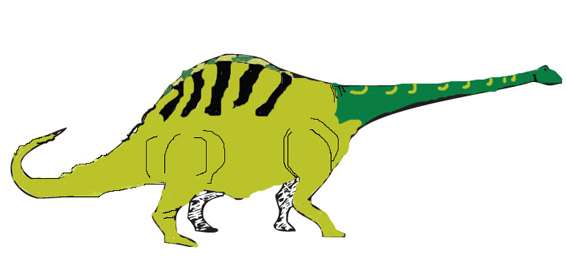Baby Sauropod Trackways Discovered in the Western United States
A set of dinosaur trackways dating from the Late Jurassic have been identified as having been made by baby sauropods, (long-necked dinosaurs). The footprints suggest that these are the trace fossils of the youngest sauropods known to science and they are providing scientists with an insight into dinosaur family life from approximately 145 million years ago. Scientists study the footprints of baby dinosaurs.
Baby Dinosaurs
Dinosaur trackways are exceptionally rare. These trace fossils can tell palaeontologists a lot about the behaviour of the animals that created them, unlike body fossils such as bones, which can be transported many miles before deposition, when you look at a footprint in the field, you are looking where a dinosaur actually walked, or in this instance ran!
An Illustration of a Typical Late Jurassic Sauropod

Picture credit: Everything Dinosaur
Everything Dinosaur team members reported on a similar discovery, back in 2008, when a series of baby Sauropod trackways were unearthed from Lower Cretaceous sediments in South Korea.
To read more about this story: Baby Sauropod Trackways Discovered in South Korea.
Baby Sauropod Footprints
The baby sauropod footprints were discovered several years ago, in foothills to the west of Denver (Colorado). The prints were found in strata that forms part of the famous Morrison Formation, a series of fossil rich, Upper Jurassic sediments that cover a substantial portion of the American Mid-west.
Matthew Mossbrucker, the Director of the Morrison Natural History Museum, discovered the prints and information about them was presented to the members of the Geology Society of America, who were holding their annual convention in Denver. Although the trackways were discovered more than five years ago, these trackways are part of a backlog of new discoveries made by the Morrison Natural History Museum staff.
Commenting on the footprints, Dr Robert T Bakker of the Houston Museum of Natural Sciences stated:
“The latest discovery is a tribute to Director Matt Mossbrucker and his crew of sharp-eyed volunteers. Never before has science given us such an intimate glimpse of baby brontosaurs – a window into Jurassic Family Values.”
Sauropod Trackways
We think these tracks are the smallest sauropod footprints ever found. They could be from a dwarf species, but most likely since they were found in association with the prints from adults, these are baby dinosaurs. The prints represent trackways made by the youngest sauropods discovered to date. In the pictures, the back of the foot is at the bottom and the five toe marks left by this little dinosaur can clearly be seen.
Each print is only a few inches across, less than a coffee mug in diameter. This suggests that it was infant sauropods that made them, measurements taken from the trackway indicate that they were perhaps no bigger than a small dog.
Whilst one dinosaur left a trackway that indicates moving at a slow walking pace, another infant left a trackway that runs parallel to adult sauropod tracks. This association is helping to provide valuable information on the behaviour of sauropod adults and young. Although this is supposition, the fossil evidence could be interpreted as a baby dinosaur following its mother, indicating a form of bonding between an adult and young.
Dinosaur Trackways
Part of one of the trackways reveals a remarkable aspect of young sauropod behaviour, making these tracks unique. Matthew Mossbrucker explained:
“The distance between each step is two-times wider than what we observe in walking tracks indicating that the animal was at a low speed run. I am not aware of any running sauropod tracks anywhere.”
What is more remarkable, is that this trackway suggests that the little dinosaur may have reared up onto its hind legs. The running trackway shows only the rear foot prints, the front foot prints may have been obliterated as the dinosaur’s hind feet landed in the space formerly occupied by its front feet as it ran. This would provide scientists with fascinating data on the dinosaur’s gait as it increased speed. However, it also raises the intriguing possibility that the absence of front feet prints in the running part of the trackway could be explained in another way. Could the baby sauropod have run on its hind legs, just like its ancient ancestors, when the need arose – a sort of facultative bipedalism, that was lost as the animal got older and heavier?
For models of sauropods and other members of the Dinosauria: Dinosaur and Prehistoric Animal Models.






Leave A Comment